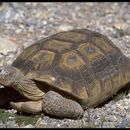en
names in breadcrumbs


The California Desert Tortoise finds its habitat throughout the desert region. They can have a 15 inch shell length, and they can weigh up to 20 pounds. The lifespan of a Desert Tortoise, on average, is 80-100 years, but some tortoises can live until 130 years old. Desert Tortoises are considered herbivores and rely on a diet of dry grasses, cacti, and flowers. The California Desert Tortoise digest its food in 20-30 days which allows for repopulation of dry grasses.
The Desert Tortoise mainly receives its water intake from the plants it eats. These tortoises can store about a quart of water in their bladder for necessary use. The adaptation of being able to store water aids in the Desert Tortoise’s survival in the arid climate. Not only does the bladder store water, but the tortoise’s scales keep moisture inside their bodies to eliminate dehydration. The California Desert Tortoise can go up to 1 year without drinking water!
Similar to other turtles and tortoises, the California Desert Tortoise moves at a slow pace; they travel at approximately 0.2 mph. By moving at a slow pace, the Desert Tortoise has to find other ways to escape predators. They have strong claws that allow for digging, and the tortoises make burrows that they share with other desert wildlife. Nevertheless, they are predatory threats to the desert tortoise that include: ravens, Gila monsters, kit foxes, badgers, roadrunners, and foxes. The predators mainly prey on juveniles because they are only 2-3 inches in length and have softer shells.